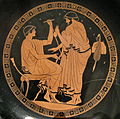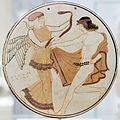Top Qs
Timeline
Chat
Perspective
Kalos inscription
Form of epigraph found on Attic vases and graffiti in antiquity From Wikipedia, the free encyclopedia
Remove ads
A kalos inscription is a form of epigraph found on Attic vases and graffiti in antiquity, mainly during the Classical period from 550 to 450 BC. The word kalos (καλός), meaning 'handsome' or 'beautiful', was often accompanied by the name of a certain man, or sometimes simply by the word pais (παῖς), meaning the 'boy' or 'youth', without naming a particular person. The female version was kalē (καλή). The kalos inscriptions typically had an erotic connotation.[2]

Remove ads
Overview
Summarize
Perspective
The kalos inscription is typically found on vessels used for a symposium. The scenes that accompany the inscription vary, and include athletic exercises and myths.
Some inscriptions are generic, reading only "the boy is beautiful" (Ancient Greek: ὁ παῖς καλός, ho pais kalos).[2] The inscription more often took the form of the beloved's name, in the nominative singular, followed by "kalos" (X kalos, i.e. "X is beautiful"). The beloved is most often a male youth, but a few times girls or women were spoken of as kalē (καλή). In one early cataloging of the inscriptions, among the individuals labeled as beautiful were 30 women and girls, and 528 youths.[3] Male names outnumber female by more than twenty to one. At least some of the women labeled kalē were hetairai, courtesans or prostitutes.[2]

The names designated as kalos are characteristic of aristocratic Athenian citizens.[2] Some kalos inscriptions are associated with certain vase painters or pottery workshops. The Antimenes Painter, for instance, is named for the kalos inscription to Antimenes on his pots, and the Leagros Group pottery workshop is named for the youth Leagros, a widely popular object of kalos praise.[2] These associations suggest a cult of celebrity or a concerted effort by a given youth's family to increase their son's public standing.
The purpose of these inscriptions remains uncertain, and many examples may be declarations of love as part of same-sex courtship in Athens.[2] In some cases, the inscriptions or vessels may have been made to order.
Kalos names are also found as graffiti on walls, the most abundant example being the find on Thassos of 60 kalos inscriptions carved on rock dating from the 4th century. The non-epigraphic literary evidence consists of two references in Aristophanes.[4] Both of these instances, however, praise the demos (the citizenry as a whole) rather than any individual, and suggest the public performance role of the kalos tag.[clarification needed]
Remove ads
Examples
- A sexual solicitation scene with generic kalos inscription, 5th century BC
- Fragment of an Attic white-ground cup with kalos inscriptions
Remove ads
References
Sources
External links
Wikiwand - on
Seamless Wikipedia browsing. On steroids.
Remove ads







